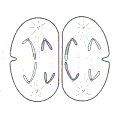Site author Richard Steane
The BioTopics website gives access to interactive resource material, developed to support the
learning and teaching of Biology at a variety of levels.
|
Site author Richard Steane
|
The BioTopics website gives access to interactive resource material, developed to support the
learning and teaching of Biology at a variety of levels.
|
|

 The 4 bases (so called because on their own they react with acids) are also usually known by their initials, as shown alongside:
The 4 bases (so called because on their own they react with acids) are also usually known by their initials, as shown alongside: |
 |
 |
 |
 |
 |
 |
 |
 |
 |
 |
| Firstly, chromosomes associate with their "partners", then each replicates, perhaps with exchange of genetic material. Secondly, chromatids separate - as in mitosis. |
 |
 |
 |
||